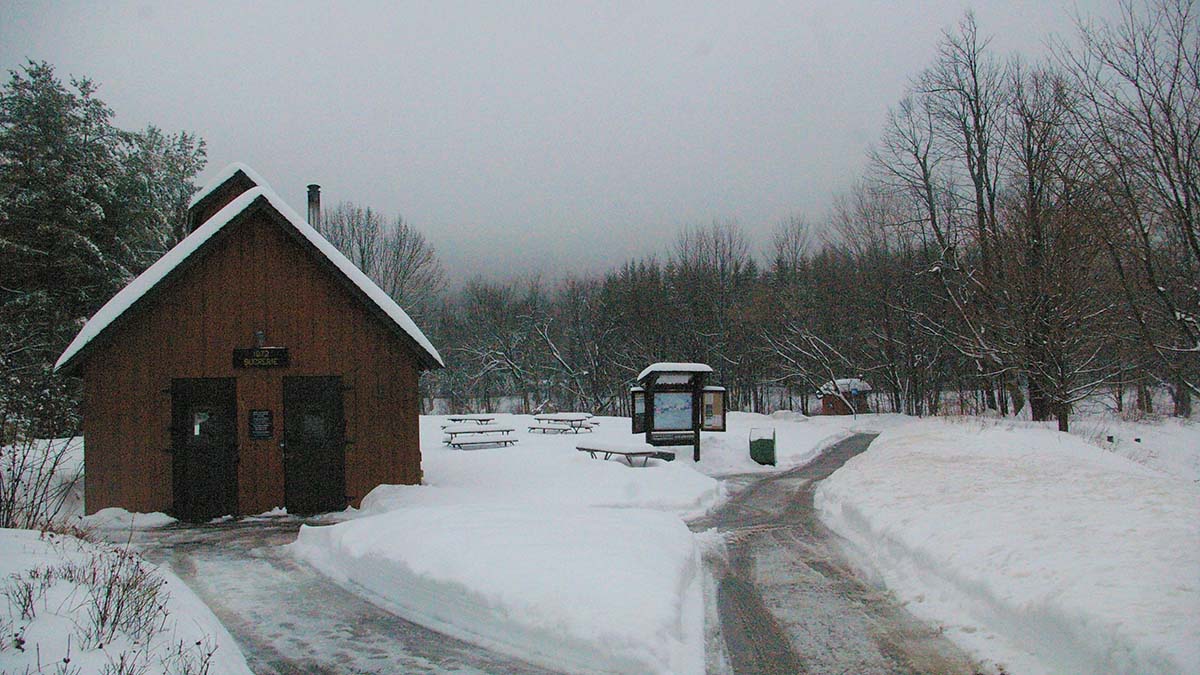
by John Geary
I could hear a familiar “Rat-a-tat-tat!” echo through the winter woods. Once I heard it, I stood stock still and listened, hoping to get a glimpse of the bird making the sound on a tree nearby.
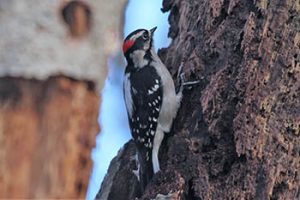 It was dead-still, no wind, and the landscape muffled by a deep carpet of snow. I slowly turned my head around like it was on a swivel, trying to pinpoint where the sound was coming from. There! I spied it: a male downy woodpecker, tapping along a tree not far off the trail we’d been trudging along. I stood there watching it for several minutes, enjoying the bird’s sounds mixing with the gurgling of nearby Chelsea Creek that was not completely frozen over and the steady crunch-crunch-crunch of snowshoes biting into the snow along the trail as others of our group caught up or continued down the rail. I took a few minutes to snap some photos, then had to move on to keep up with the rest of the group.
It was dead-still, no wind, and the landscape muffled by a deep carpet of snow. I slowly turned my head around like it was on a swivel, trying to pinpoint where the sound was coming from. There! I spied it: a male downy woodpecker, tapping along a tree not far off the trail we’d been trudging along. I stood there watching it for several minutes, enjoying the bird’s sounds mixing with the gurgling of nearby Chelsea Creek that was not completely frozen over and the steady crunch-crunch-crunch of snowshoes biting into the snow along the trail as others of our group caught up or continued down the rail. I took a few minutes to snap some photos, then had to move on to keep up with the rest of the group.
We were spending a winter afternoon snowshoeing through woods of Gatineau Park, one of eastern Canada’s natural gems. Located not far from our country’s capital, Ottawa, just over the border in the province of Quebec, it’s a snowshoe aficionado’s dream, with roughly 60 km of trails set aside just for snowshoeing during the winter months, ranging from easy to difficult.
Often thought of as a sanctuary of nature and natural history – it is home to deer, beaver, black bear and nearly 230 bird species – the 36,000-hectare park lies in an area where the Canadian Shield meets the St. Lawrence Lowlands and where the Ottawa River meets the Gatineau River. In addition to its wonderful natural history, it also boasts a wonderful cultural history going back several centuries.
Author Katherine Fletcher writes of this rich history in her book, Historical Walks : The Gatineau Park Story, a wonderful resource to use to get the most enjoyment out of the park, whether you’re there in the winter, spring, summer, or fall.

Just by choosing to travel the park by snowshoe is a choice to travel through history; snowshoes were used by the indigenous people of the area – the Anishinabe – whose history dates back some 8,000 years. It’s their footsteps we were walking in, breathing the air they’d breathed, hearing the same waterways they’d heard.
As several of our group had never been on snowshoes before, we were a bit limited in how far afield we could go during our tour. After getting outfitted with snowshoes in the visitor centre, we began our trip in the old “Sugar Shack,” with our guide telling about some of the history of the park.
Twenty minutes later, we were out on the trail, headed across Chelsea Creek over an old wooden bridge and onto the “Sugar Bush Loop.” The weather had been very good to us – just a few days before, it had been raining, but a cold spell quickly ended the rain and brought more snow to top what was already on the ground and almost-perfect weather for making like modern-day coureurs-de-bois (“runners of the woods”). Pierre Radisson and Médard des Groseilliers, step aside!
 We were only on the trail about 15 minutes before our woodpecker friend showed up. Within another 10 minutes we saw signs of another of the park’s inhabitants: rabbit tracks. No sign of the bunny that made them, though.
We were only on the trail about 15 minutes before our woodpecker friend showed up. Within another 10 minutes we saw signs of another of the park’s inhabitants: rabbit tracks. No sign of the bunny that made them, though.
We continued to tramp through the snowy woods for the next few hours, stopping from time to time as our guide pointed out or talked about interesting natural and cultural history aspects of the park.
Like many European settlers to North America, the first wave of immigrants from across the pond wanted to live by farming in the Gatineau area. However, the area’s rocky soil was not well-suited to agriculture, forcing them to turn to resource-based activities like hunting, fishing, forestry, and mining to earn a living from the land. Traces of homesteads and mines can still be seen in the park, today.
Although the fur trade was in full-swing during the early colonization of the area by the French and later the English in the late 17th, 18th, and early 19th centuries, the Gatineau area did not play a huge role as the trade developed into a large industry, for a variety of reasons: early on, the area was frequented by Iroquois and Algonquin tribes, so fighting often ensued between the traditional enemies.
Later on, location and size of the area rivers and other waterways – many which were too small for the bigger freighter canoes used by traders out of Montreal – saw them bypassed in favor of larger waterways, like the Ottawa River. (Interesting trivia point: a Gatineau family was involved in the fur trade – but they were based in Trois Rivieres a.k.a, Three Rivers.)
During the early 1800s, the area became very important for its timber resources, as the wood cut there went to build ships for the British navy. That continued for much of the century until changing technology reduced greatly the need for timber as wood gave way to metal in ship-building.
In the late 19th century, affluent residents in the Ottawa area began seeking outdoor recreation in the woods of the Gatineau Hills. Some – like William Lyon Mackenzie King – built cottages in the area. Some remains survive to this day, including remnants of the King estate, which grew from a simple summer cottage into an estate befitting a Canadian prime minister.
Of course, this was not a “park” officially until 1938, when the government began to acquire parcels of land and eventually turned it into the multi-use facility it is today, with historical, cultural, and natural attractions for visitors.
While we learned much of this from our guide during our tour stops, time prevented us from seeing many of the historic gems described, which were further afield in the park.
But that just provides an excuse to go back again, and spend time exploring the park and its history.
SUGGESTED SITES TO VISIT:
While I didn’t get a chance to investigate most of these in person, a few highlights you’ll want to try to see include…
The 231-hectare Mackenzie King country estate that belonged to Canada’s 10th and longest-serving prime minister.
The “Carbide” Willson ruins. Located at Meech Lake, the ruins of a generating station can be seen here.
The Sugar Shack; formerly located along the Sugar Bush Trail, now near the visitors’ centre, this is where we finished and started our hike. Built in 1972, it used to operate until cutbacks forced its closure. But it’s still a great place to warm up after an outing!
If You Go:
Getting to Ottawa from any major city in North America is not a problem; several international airlines service the international airport in Canada’s capital.
Gatineau Park’s main visitor centre and access to some of the trails is an easy 15 to 20-minute drive from Ottawa’s Parliament Hill.
Get on Autoroute 5 N in Hull, Gatineau from Wellington St/Ottawa 34, Portage Bridge and Boulevard Maisonneuve N. Follow Autoroute 5 N to Chemin Scott in Chelsea. Take exit 13 from Autoroute 5 N. Follow Chemin Scott to the park.
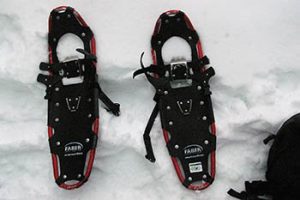 If snowshoeing, you can bring your own, or rent from the visitor centre. If you plan to rent – or if you plan to participate in a guided tour – contact the centre first to make you’ll be able to get shoes and a guide the day and time you want.
If snowshoeing, you can bring your own, or rent from the visitor centre. If you plan to rent – or if you plan to participate in a guided tour – contact the centre first to make you’ll be able to get shoes and a guide the day and time you want.
You may want to pick up a copy of the Fletcher book; it contains maps of the trails as well as a difficulty rating for each trail along with its comprehensive history of the park.
You’ll certainly want to check out the website ncc-ccn.gc.ca/places-to-visit/gatineau-park. Any contact info you need regarding use of the park can be found on that site.
You can also contact Tourism Ottawa.
The Friends of Gatineau can also be very helpful in planning your trip there – and they also offer some guided tours.
Other attractions you may want to visit while in Ottawa:
the Canadian Museum of History, located in the Hull area of Gatineau, again, very close to Ottawa.
the Canadian War Museum
the Canadian Museum of Nature
About the author:
John Geary is a full time freelance writer/photographer and social media manager with more than 30 years of experience working in broadcast, print, and digital media. He has traveled the world as a freelance travel journalist. He often focuses on birds and wildlife and paddling adventures in his travel writing.
Photographs by John Geary:
The Sugar Shack – where we began and ended our outing
Downy woodpecker doing its thing
Rabbit tracks! No sign of the bunny, though
Snowshoes are a great way to see the park in winter



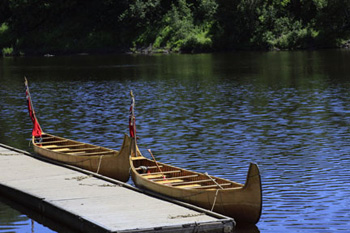
 To get the furs to Fort William, the 90-pound bales of furs were loaded into 25-foot Northwest birch-bark canoes, along with the outpost’s agent and supplies needed for the trip, and paddled on the liquid highway by four to six voyageurs. Each canoe carried up to 1-½ tons of cargo and people. The canoes were developed by the Ojibway Indians in the area and the Northwest Company went to great lengths to keep their competition from having access to that flat-bottomed canoe, the perfect watercraft vehicle to navigate the shallow rivers and streams of Northern Minnesota and Lower Canada. The Hudson Bay and American Fur Companies use the less efficient “York” canoe.
To get the furs to Fort William, the 90-pound bales of furs were loaded into 25-foot Northwest birch-bark canoes, along with the outpost’s agent and supplies needed for the trip, and paddled on the liquid highway by four to six voyageurs. Each canoe carried up to 1-½ tons of cargo and people. The canoes were developed by the Ojibway Indians in the area and the Northwest Company went to great lengths to keep their competition from having access to that flat-bottomed canoe, the perfect watercraft vehicle to navigate the shallow rivers and streams of Northern Minnesota and Lower Canada. The Hudson Bay and American Fur Companies use the less efficient “York” canoe. The brigades coming in from the Yukon in the far west stayed about a week at Rendezvous before they had to start back to the outpost before the rivers froze. Those coming in from closer outposts, such as one of the Fond de Lac’s outpost on Minnesota’s Snake River (near modern day Pine City, MN), stayed longer.
The brigades coming in from the Yukon in the far west stayed about a week at Rendezvous before they had to start back to the outpost before the rivers froze. Those coming in from closer outposts, such as one of the Fond de Lac’s outpost on Minnesota’s Snake River (near modern day Pine City, MN), stayed longer. Today, you can experience Grand Rendezvous the second weekend of July each year or explore the fort anytime. I wanted to experience what is was like paddling a Nor’west canoe on the Kaministiquia River just as the voyageurs did in the early 1800s. Free 20-minute trips leave the wharf several times each day between 10:00 am and 2:00 pm. Don’t worry – each of the six to eight modern “voyageurs” per canoe must wear a lifejacket and learn the commands of paddling. Each canoe has a period-costumed experienced bowman in the front and a steersman in the back.
Today, you can experience Grand Rendezvous the second weekend of July each year or explore the fort anytime. I wanted to experience what is was like paddling a Nor’west canoe on the Kaministiquia River just as the voyageurs did in the early 1800s. Free 20-minute trips leave the wharf several times each day between 10:00 am and 2:00 pm. Don’t worry – each of the six to eight modern “voyageurs” per canoe must wear a lifejacket and learn the commands of paddling. Each canoe has a period-costumed experienced bowman in the front and a steersman in the back.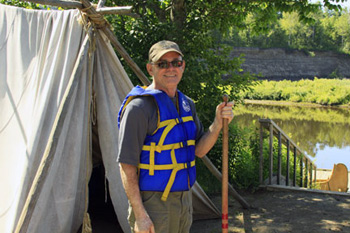 Once back at the wharf, I walk toward the main gate leading into the fort. Just before going under the gate archway, on the right is a small voyageur encampment. One of the voyageurs just finished cooking some fish over the campfire. The voyageurs were not allowed to stay inside the fort palisade. The fort interior was reserved for gentlemen, such as clerks, bourgeois and tradesmen, along with the elite of the company – the company partners.
Once back at the wharf, I walk toward the main gate leading into the fort. Just before going under the gate archway, on the right is a small voyageur encampment. One of the voyageurs just finished cooking some fish over the campfire. The voyageurs were not allowed to stay inside the fort palisade. The fort interior was reserved for gentlemen, such as clerks, bourgeois and tradesmen, along with the elite of the company – the company partners.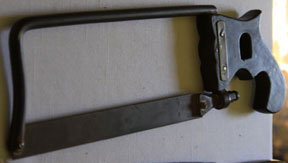 I scanned the room looking at his equipment and “medicines” and noticed a saw lying on a table. Doc explains the limb amputation process and that he used it as a last resort – the success rate is not good as only about one out of every two ever healed and lived. Most of the amputees succumbed to infection. Those requiring long-term convalescence were moved to the hospital on the other end of the square. An amputation ended the person’s employment as a voyageur. Voyageurs needed both strong arms to paddle for weeks on end and both strong legs to haul the equipment over portages, some as long as 14 miles.
I scanned the room looking at his equipment and “medicines” and noticed a saw lying on a table. Doc explains the limb amputation process and that he used it as a last resort – the success rate is not good as only about one out of every two ever healed and lived. Most of the amputees succumbed to infection. Those requiring long-term convalescence were moved to the hospital on the other end of the square. An amputation ended the person’s employment as a voyageur. Voyageurs needed both strong arms to paddle for weeks on end and both strong legs to haul the equipment over portages, some as long as 14 miles.
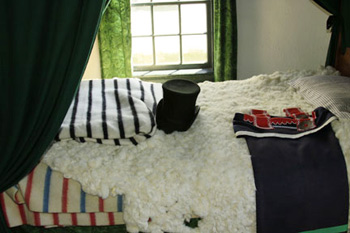 In the kitchen and bakery, three “cooks” are busy preparing fare for the noon meal. With fowl hanging and some already cooking in the reflector oven, one cook is breaking home-baked bread into pieces in preparation for making bread pudding. Another is cutting scallions as one ingredient for use in a prepared dish. With 1,200 in camp, it was a busy two months for the cooks keeping up with the hungry demands.
In the kitchen and bakery, three “cooks” are busy preparing fare for the noon meal. With fowl hanging and some already cooking in the reflector oven, one cook is breaking home-baked bread into pieces in preparation for making bread pudding. Another is cutting scallions as one ingredient for use in a prepared dish. With 1,200 in camp, it was a busy two months for the cooks keeping up with the hungry demands. Our final stop is at the Wintering House of Kenneth McKenzie and his family. McKenzie was the Northwest’s chief operating officer at Fort William. Officially established in 1784, NWC was actually a loosely knit coalition of independent traders based in Montreal that operated under an arrangement of agreements with fur traders and Indians in the interior. They never did have an official charter as did their rival the Hudson Bay Company. At the head of the company was Simon McTavish, a Scottish Highlander, who ran the company from its beginning until his death in 1804. Each summer for a couple of weeks, he would come out from Montreal to visit Fort William. In the Great Dining Hall, a room off to the side was always kept ready for his arrival. McTavish brought three of his nephews William, Duncan and Simon McGillivray into the fur business. William rose to head the company after his uncle’s death.
Our final stop is at the Wintering House of Kenneth McKenzie and his family. McKenzie was the Northwest’s chief operating officer at Fort William. Officially established in 1784, NWC was actually a loosely knit coalition of independent traders based in Montreal that operated under an arrangement of agreements with fur traders and Indians in the interior. They never did have an official charter as did their rival the Hudson Bay Company. At the head of the company was Simon McTavish, a Scottish Highlander, who ran the company from its beginning until his death in 1804. Each summer for a couple of weeks, he would come out from Montreal to visit Fort William. In the Great Dining Hall, a room off to the side was always kept ready for his arrival. McTavish brought three of his nephews William, Duncan and Simon McGillivray into the fur business. William rose to head the company after his uncle’s death. Northwest’s interior headquarters was not always located on the Kaministiquia River near Thunder Bay. Before 1803, their depot was located on the shore of Lake Superior. However, being a British company and with the border between the United States and Canada not yet drawn, they feared they would end up as part of the United States and end up paying large pay custom duties, so they moved north so they would be well inside Canada. It was a wise move as Grand Portage did end up in the United States. In 1821, the Northwest Company ceased to exist as they were swallowed up by the Hudson Bay Company, a chief rival of theirs since 1793.
Northwest’s interior headquarters was not always located on the Kaministiquia River near Thunder Bay. Before 1803, their depot was located on the shore of Lake Superior. However, being a British company and with the border between the United States and Canada not yet drawn, they feared they would end up as part of the United States and end up paying large pay custom duties, so they moved north so they would be well inside Canada. It was a wise move as Grand Portage did end up in the United States. In 1821, the Northwest Company ceased to exist as they were swallowed up by the Hudson Bay Company, a chief rival of theirs since 1793.

